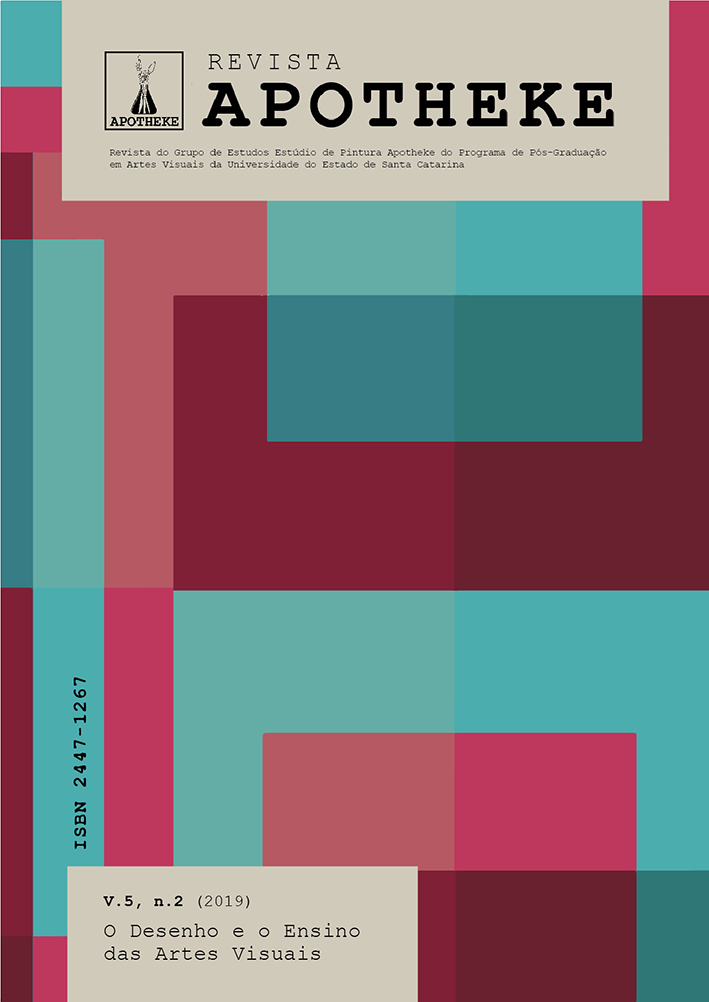Histórias do Ensino do Desenho
DOI:
https://doi.org/10.5965/24471267522019129Abstract
The Notebooks of Leonardo da Vinci,1 copilados e editados dos manuscritos originais por Jean Paul Richter são evidências cabais de que para Leonardo o desenho era fundamental em todas as suas múltiplas atividades.
Contudo nos dias atuais há um desinteresse enorme por pesquisas que esclareçam a importância do desenho para profissionais projetistas, para o cotidiano das pessoas, para o desenvolvimento da cognição e na educação para as Artes, para o Design, para a Arquitetura.
Até mesmo o desenho da criança tão estudado até a década de 80 tem sido esquecido. De Luquet (1913) a Claire Golumb (1992)3 muita pesquisa confiável foi produzida sobre a evolução do desenho livre da criança, mas o que se escreve e se vende hoje são meras receitas para aprender a desenhar, entre elas o livro Drawing on the Right Side of the Brain Workbook (1998)4.Os exercícios que Betty Edwards propõe neste livro produzem bons resultados por serem desinibidores da expressão, mas cientificamente nenhuma pesquisa demonstrou que realmente ativam o lado direito do cérebro.
Downloads
References
BARBOSA, Ana Mae. Arte-Educação no Brasil: das origens ao modernismo. São Paulo: Editora Perspectiva, 1978.
BARBOSA, Ana Mae. Redesenhando o desenho: educadores, política e história. São Paulo: Editora Cortez, 2015.
EDWARDS, Betty. Drawing on the Right Side of the Brain Workbook. 1998, Penguin Putnam.
GOLOMB, Claire. The Child’s creation of a Pictorial World. Berkeley, Los Angeles, Oxford. University of California Press, 1992, 353 pgs.
LUQUET, Georges-Henri. Les dessins d'un enfant (Children’s Drawings). Paris, Librairie Félix Alcan, 1913.
MILANEZ, Carolina Gonçalves. Ensino da Arte e do Design em uma escola municipal de São Paulo. Universidade Anhembi Morumbi, Programa de Arte. Design e Tecnologia, 2016.
REBOUÇAS, André. Diário e Notas Autobiográficas. Coleção Documentos Brasileiros dirigida por Gilberto Freyre. Livraria José Olympio Editora, Rio, pág. 395 a 397, 1938.
The Notebooks of Leonardo da Vinci compiled and edited from the original manuscripts by Jean Paul Richter. New York: Dover Publications, 1970.
VARTULI, MAximilian de Aguiar. O design do desenho: análise de ferramentas de desenho digital no projeto de produto. Mestrado Acadêmico em Design UDESC /CEART, 2016 pag 24.
SANOVICZ, Fernanda. Desenhos de Abrahão Sanovicz. São Paulo: SESC,2016.
Downloads
Published
How to Cite
Issue
Section
License
Copyright (c) 2019 REVISTA APOTHEKE

This work is licensed under a Creative Commons Attribution-NonCommercial 4.0 International License.
Copyright and Licensing Policy
Authors of works submitted to Revista APOTHEKE authorize their publication in both print and digital formats exclusively for academic purposes. Reproduction is permitted, provided that the source is properly cited. Authors confirm the originality, authorship, and unpublished status of their manuscripts.
Articles published by the journal are freely available and intended for academic and non-commercial use only. All copyrights are transferred to the journal. The content of signed articles reflects the views of their respective authors and not the official position of Revista Apotheke. The author(s) agree to always cite the following reference when republishing or referring to the content originally published in Revista Apotheke:
“This article was originally published by Revista Apotheke in volume (insert volume), number (insert number), year (insert year), and is available at: http://www.revistas.udesc.br/index.php/APOTHEKE/index”
It is the sole responsibility of the authors to obtain written permission for the use of any material protected by copyright law included in their articles. Revista Apotheke is not responsible for copyright infringements committed by contributors.
Authors retain copyright and grant the journal the right of first publication, with the work licensed under a Creative Commons Attribution-NonCommercial License (CC BY-NC):
-
Attribution (BY): Licensees are allowed to copy, distribute, display, perform, and create derivative works, provided that proper credit is given to the author or licensor, in the manner specified.
-
NonCommercial (NC): Licensees may use the material only for non-commercial purposes.
After publication, authors retain the rights to their work and may republish the text.



